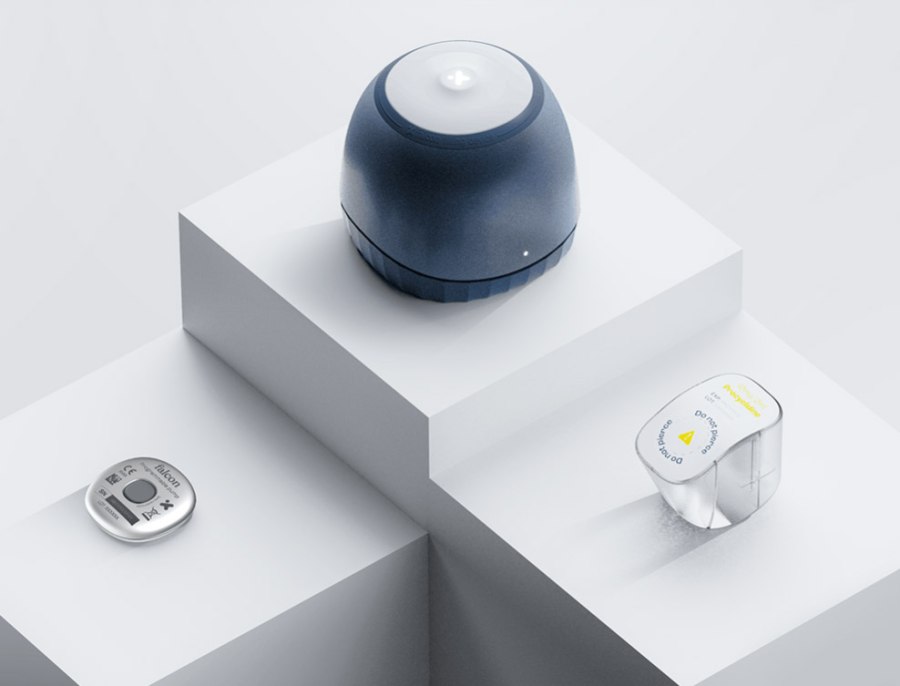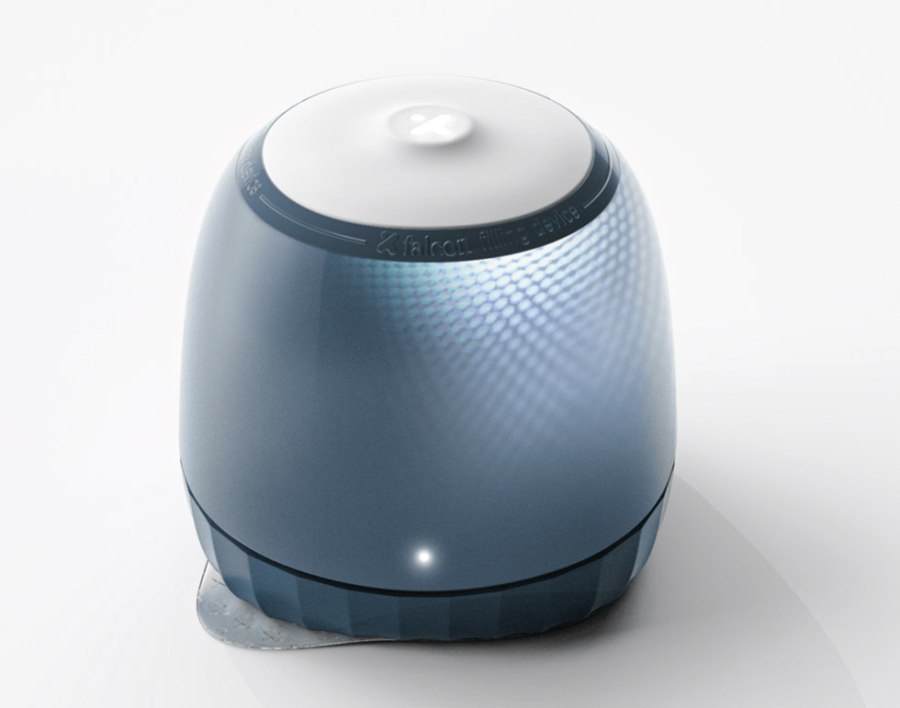Implantable drug delivery is an area that is ripe for innovation and commercial growth. A host of unmet patient needs are awaiting solutions – ironically at a time when maturing technologies are offering novel ways to improve drug delivery. Against this backdrop of market stagnation, a multidisciplinary team of colleagues at Cambridge Consultants has seized the initiative with a miniaturised delivery implant and at-home refilling device concept, named Falcon. It represents a potentially transformative breakthrough in engineering and design innovation.
The Falcon concept comprises a medication-releasing implant and a novel filling device that allows a patient or healthcare professional to intuitively fill the implant. The miniaturised implant is smaller than conventional solutions designed decades back specifically for abdominal implantation – so can be positioned in harder to reach areas within the patient’s anatomy to pave the way to broader treatment of a wider range of therapeutic conditions and even direct-to-organ delivery. Because the implant and its drug reservoir are smaller than current offerings, regular filling is required – hence the need for an elegant, safe and easy to use solution.
These twin breakthroughs in miniaturisation and precision engineering offer biopharma companies the promise of providing different treatment options in new therapeutic areas for more patient groups. It’s exciting, ground-breaking stuff, and for me it’s been a thrill to help lead the multidisciplinary team of designers, scientists and engineers who took up the challenge.
Much of the work was inspired by experts at CC who are passionate advocates of next-generation drug delivery. This article on active implants unpacks key ways to overcome the technological challenges of miniaturisation. It also explains the many benefits of such targeted therapy devices.
As well as long-term drug administration, miniature implants come with a range of drug-specific capabilities such as discrete administration, patient and caregiver safety and smoother pharmacokinetic and pharmacodynamic profiles than the peaks and troughs that often result from frequent injections.
The drug delivery system concept
Our concept development began with a review of current drug delivery implants, which are so large that anatomical placement options are typically limited to a patient’s abdominal cavity. Quite obviously this limits the potential of targeted therapy adoption, because such a position is inappropriate for therapeutics that demand direct-to-organ delivery.
As mentioned earlier, a miniaturised implant solves this key issue but introduces the further conundrum of how to refill a smaller drug reservoir more often without increasing patient burden or jeopardising safety. Implants are currently filled by healthcare professionals in a medical environment. Increasing the frequency would put more pressure on care services.

The requirement, therefore, was for an external smart device that patients themselves or carers could use to accurately locate their implant position and then allow patients to independently fill the implant drug reservoir. From the get-go, the notion of patient ease and empowerment was high on our agenda of required outcomes.
During early project activities, we identified numerous usability challenges. Smaller implants positioned in harder to reach places are especially liable to movement within the body. For a patient, accurately determining the position of their implant and then filling its reservoir through the skin barrier without assistance or training is not possible.
Reusable implant filling system
The concept system comprises an implant, single-use medication cartridges and a reusable filling device. Currently available implants are filled manually. This is because filling is a precise activity that requires a painstaking process of finding the implant by hand and then injecting manually. Manual filling makes sense for current implants because – due to their size – current implants only need filling every six to 12 months. A significant proportion of the complexity is locating the implant port.
As a smaller implant has a smaller reservoir, the filling of the Falcon implant needs to be completed every four to eight weeks. This means manual filling by a healthcare professional is not appropriate because of increased patient burden and cost to health services. As a result, we designed our concept to harness ultrasound sensing to accurately determine the position of the implant through triangulation – giving a clear indication of implant rotation and depth within a 3D space. Once the implant is located, the device intuitively guides patients to position the device above the implant, harnessing haptic, audio and visual feedback to inform the patient when suitably positioned.
Transforming the future of medical innovation.
Upon successful positioning of the refilling device above the implant, an electromagnetic system enables the micro-adjustment of the drug cartridge to precisely align its needle to the centre of the implant port. During this automated process, the device is held in place by a reusable adhesive which adds physical support and peace of mind for patients. We’re confident that a patient or carer could carry out this process at home, perhaps with regular check-ins from a medical professional every now and then.
Enhancing the user experience
What makes our concept so easy and intuitive for patients? The filling device features a tactile user interface on its top surface which can be felt by patients on their palm. This feature is able to move and thus communicated the direction which patients should move the device to align it above the implant. The user experience is further enhanced by directional glowing and vibrational pulsing. When the device is correctly positioned, an audio signal gives patients the confidence they need to proceed with refilling.
State-of-the-art ultrasound sensing is adopted at the heart of the system. As the user positions the filling device over the implant, emitted ultrasound waves are reflected off the implant and received by sensors added inside the device. This information is then used to triangulate the location and orientation of the implant with such accuracy.

An electromechanical system allows the cartridge to rotate through 360 degrees and tilt up to 24 degrees. This capability provides a range of motion sufficient to ensure that the filling needle is precisely aligned to the implant port. The cartridge angle and tilt are micro-adjusted to align with the centre of the port to free patients from the worry of tricky self-injection. During the injection, any residual drug is flushed out of the implant and a fresh 30-day supply of medication replaces it.
In summary, we firmly believe that innovation with the area of miniature active implants is the next big opportunity space for development in MedTech. Platforms like Falcon can open innovative doors for bio pharma companies to deliver challenging therapies that aren’t possible with existing approaches. The key questions are how far can we push miniaturisation and how far can we go in terms of flexibility to deliver challenging therapies? If you’d like to discuss any aspect of this topic, and perhaps discuss your ambitions in the space, please do get in touch with me.





